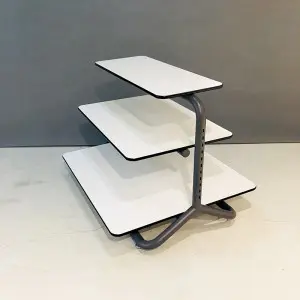Aug . 14, 2024 01:01 Back to list
Creative Strategies for Enhancing Retail Displays and Fixtures to Boost Customer Engagement and Sales
Creating an Inviting Display The Importance of Store Fixtures in Retail
In today’s competitive retail landscape, creating an enticing shopping environment is crucial for attracting and retaining customers. One of the key elements that contribute to this environment is display and fixture design. Effective store fixtures not only enhance the visual appeal of a retail space but also improve functionality, guiding customers through their shopping experience and ultimately driving sales.
Store fixtures refer to the various permanent or semi-permanent furnishings that display products to customers. This includes shelves, racks, display cases, tables, and mannequins. Each fixture serves a specific purpose and can significantly impact how products are perceived by the consumer. This article explores the importance of display and fixture design in retail, highlighting its role in product presentation, customer experience, and brand identity.
The Role of Display in Product Presentation
Effective product presentation is vital in retail. Customers are naturally drawn to well-organized and aesthetically pleasing displays. Good display techniques highlight the features and benefits of products, making them more appealing. For instance, using visually striking fixtures can create focal points that draw attention to specific products or promotions. End caps, for example, can be strategically used to showcase seasonal items, encouraging impulse purchases.
Moreover, the use of appropriate lighting for displays enhances the colors and textures of products, making them more inviting. Display fixtures can also be designed to create a thematic experience, such as rustic furniture for a farm-to-table restaurant or sleek, modern shelving for a high-tech gadget store. These themes not only help in effectively showcasing products but also resonate with the target audience, reinforcing brand messages.
Enhancing the Customer Experience
Customer experience plays a pivotal role in the success of any retail venture. Well-thought-out store fixtures contribute significantly to this experience. An intuitive layout, driven by strategically placed fixtures, allows customers to navigate the store with ease. Thoughtful design can reduce overcrowding, facilitate customer flow, and encourage exploration of the store.
display and fixture store

For example, placing fixtures at different heights can create visual interest and complexity within a space, making it more engaging. Additionally, incorporating interactive displays and multi-functional fixtures can encourage customers to engage with products, offering them a hands-on approach that deepens their understanding and connection to the items for sale.
Furthermore, the arrangement of fixtures can influence purchasing decisions. Research has shown that customers are likely to buy more when products are arranged in a visually appealing and logical manner. Retailers should consider the placement of high-margin items at eye level and ensure that seasonal or promotional goods are easily accessible to stimulate sales.
Reflecting Brand Identity
Store fixtures are also a powerful tool for reflecting and reinforcing brand identity. The design, material, and color of fixtures can communicate a brand’s values and personality. For example, a luxury brand may opt for sleek, high-end display cases made of glass and metal, while a sustainable brand might choose fixtures made of reclaimed wood to convey a commitment to environmental responsibility.
The consistency in design across all store fixtures and displays fosters brand recognition, as customers associate specific styles, colors, and layouts with particular brands. This connection can lead to increased customer loyalty and repeat business, as consumers often prefer brands that resonate with their values and lifestyles.
Conclusion
In conclusion, the design and implementation of display and fixture solutions in retail are critical to creating an engaging shopping experience. By thoughtfully presenting products, enhancing customer navigation, and reflecting brand identity through design, retailers can significantly impact shopper behavior and drive sales. As the retail landscape continues to evolve, investing in innovative and effective display solutions will be paramount for businesses seeking to thrive in a crowded marketplace.
-
The Benefits of Electronic Shelf Labels for Modern Stores
NewsJul.01,2025
-
Space-Saving Retail Store Furniture Designs for Small Shops
NewsJul.01,2025
-
Slatwall vs. Gridwall: Which Store Fixture is Right for Your Business?
NewsJul.01,2025
-
Shop Fittings: Essential Elements for a Functional Retail Space
NewsJul.01,2025
-
How to Design a Minimalist Cosmetic Shop Display
NewsJul.01,2025
-
Creative Clothes Shop Display Ideas to Attract More Customers
NewsJul.01,2025


















































































































